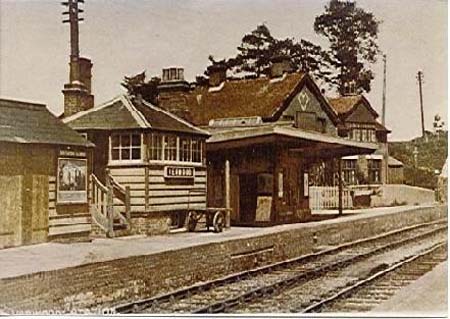|
Date |
Details of the Event from 930
to 1899 AD
|
|
930 |
The
Saxons had established a priory in Cranborne in what later became the vicarage
garden. Cranborne was known as Creneburne in Domesday records which recorded it
as one of the Kings Manors. Cranborne takes its name from the river which winds
its was through Pentridge and Verwood to the Moors Valley where it changes its
name..
|
|
1199 |
From this date Cranborne Chase was
acquired by the Crown when King John hunted.
|
|
1220 |
In 1220 STEPHEN'S STONE was
recorded as "LE HORESTONE" and was a boundary point in this area so could
be a BOUNDARY STONE. - Legend has it that STEPHEN'S STONE, a solitary block of
stone in WILD CHURCH BOTTOM has a GOLDEN CASKET beneath it. It is said
that it measures 6M X 3M X 3M approx.
|
|
1288 |
VERWOOD was first recorded as Beubos or “Beau Bois”.
|
|
1329 |
VERWOOD
was first recorded. It was developed from FAIRWOODE, FAYRWOOD, WRTWOOD &
WEIRWOOD. (The Dorset accent may have something to do with this.
|
|
1348 |
It is
believed that the Black Death
was brought into Weymouth in a foreign ship.
|
|
1377 |
Verwood
was mentioned in a charter dated
the 8th December 1377 as “Fairwoode”
though the name of its Norman landowners the “Beau Bois” family
of Edmondsham is recorded earlier in 1288.
The Norman Lord, William de Bello Bosco or Beau Boys had used the
Latin or Old French translation of the locality for his surname
In the 1377 charter "all the lands, tenements, meadows, woodland, heath,
marsh, pasture, rents and services" which William de Bello Bosco held in
Fairwoode, to named persons. Fairwood continued as the official name into the
19th century when it evolved into Verwood.
|
|
1539 |
A
strange ball on the tomb of Sir Anthony Ashley in Church at Wimborne
St Giles represents a Cabbage which he introduced from Holland in 1539. The
first Cabbage grown in England was in the kitchen garden at St Giles
House.
|
|
1579 |
A
fire occurred in Blandford which destroyed records of the area. (inc
Verwood.)
|
|
1603 |
Cranborne Chase
transferred from the Crown.
|
1685
June 11th |
 The
Pretender to the Throne, the Duke of Monmouth, landed on the beach at
Lyme Regis with around 80 men. (Follow link for full story). The
Pretender to the Throne, the Duke of Monmouth, landed on the beach at
Lyme Regis with around 80 men. (Follow link for full story).
|
|
1731 |
Another serious fire occurred in
Blandford which destroyed many more records
in the area. This followed the 1579 fire and two smaller fires in 1676 and 1713.
Unidentified children orphaned by these fires were given the surname Blandford.
|
|
1756 |
The
eighteenth century brought with it the building of many turnpike roads.
By 1756 there were several turnpike roads from Poole Gate into Cranborne Chase.
|
|
1759 |
By this
time two more turnpike roads were established in the area, from Winchester
through Romsey, Ringwood, Longham to Wimborne Minster and from Ringwood through
Woolsbridge, Horton and Thickhorne to Cashmore.
|
|
1760 |
Cranborne was found on the high road from London to the west and a turnpike road
from Poole Gate to Salisbury was established by Act of Parliament in the reign
of George III and a milestone can still be seen on the roadside between Toyd
Farm and the Blandford-Salisbury road marking this turnpike.
|
|
1802 |
The first CONGREGATIONAL CHURCH
(now the U.R.C.) was
established but there
appears no information of the site of this building.
|
|
1829 |
An Anglican
mud walled Chapel of Ease in the
parish of Cranborne was erected and consecrated on the site of the present
Parish
Church.
|
|
1837 |
The
Church of England Infant School
was established as a National
School
when school was held in the church.
|
|
1847 |
A
Church of England Infant School room
to accommodate one hundred and twenty children and a school house were
built at a cost of two hundred and
sixty pound. John Carnegie (Vicar of Cranborne 1841-72) had the
schoolroom built.
|
|
1866 |
  The railway from Salisbury
to the coast arrived in Verwood and was part of the
Salisbury
and Dorset
branch of the
London and South West Railway.
It was a single track line with a passing loop at Verwood Station. This
was a small station situated on the south side of the Albion Inn. The bridge can
still be seen. The railway from Salisbury
to the coast arrived in Verwood and was part of the
Salisbury
and Dorset
branch of the
London and South West Railway.
It was a single track line with a passing loop at Verwood Station. This
was a small station situated on the south side of the Albion Inn. The bridge can
still be seen.
|
|
1870 |
The Anglican Parish Church
added a brick Chancel to the existing church.
|
|
1876 |
A Primitive Methodist Church
was built on the present site. It was replaced in 1909 and is now the
Methodist Church which was again later extended
|
|
1877 |
The second
CONGREGATIONAL CHURCH was built as the
previous 1802 building had "fallen into decay and was deemed unsafe".
This is now the Verwood Library.
|
|
1879 |
The present Woodlands
Methodist Church
foundation stone was laid on
8th May 1879
and the building opened in opened on the 23rd October. The land was
acquired for £10 on a 21year lease and the total cost of the new building was
£582.2.7.
|
|
1880 |
The non-conformist day
classes becomes the British School.
|
|
1886 |
The Anglican Parish Church
was in a state of disrepair and the galleries unsafe. These were taken down and
the nave was rebuilt using local Verwood bricks.
|
|
1887 |
Verwood created a Parish
severing its long association
with Cranborne.
|
|
1887 |
A Brick "Independant Chapel" (Currently the Library) was built as
a combined Church and Schoolroom. |
|
1887 |
The First Vicar of Verwood (The Rev. Claude Brown) arrived
which brought many benefits to the Church and Village |
|
1891 |
The United Reformed Church
in Ringwood Road, 3X, opened its
present Church.
|
|
1891 |
Kelly's Dorsetshire Directory,
1895 records the 1891 population of Verwood at 1,190.
|
|
1892 |
A new chancel and vestry
were built in the Verwood Anglican Parish Church, the cost being met by
the Reverend Claude Brown M.A. (Wadham
College, Oxford), and the churchyard was also enlarged.
|
|
1893 |
A daughter Anglican Parish
Church was built at Three Legged Cross (All Saints). It was built of
corrugated Iron and was known as the tin church.
|
|
1894 |
The Verwood Anglican Parish
Church nave and western
baptistry were dedicated together with the west porch and bell turret. A
memorial marble font with a curved oak cover was added together with a wrought
iron screen round the font and one at the chancel.
|
1894
Mar 5th |
Verwood became a Civic
Parish.
|
1894
Mar 29th |
The last meeting of the
Cranborne Vestry responsible for Cranborne and Verwood was held.
|
1894
Dec. 17th |
The first elections for the newly formed Verwood Parish Council
were held. We know because the Verwood National School Log Book (held in
the County
Archives
in
Dorchester) records the school as being closed for that
purpose on that day
|